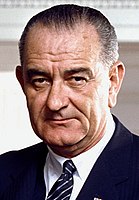1964_United_States_presidential_election_in_Pennsylvania
1964 United States presidential election in Pennsylvania
Election in Pennsylvania
The 1964 United States presidential election in Pennsylvania took place on November 3, 1964, and was part of the 1964 United States presidential election. Voters chose 29 representatives to the Electoral College, who voted for president and vice president.
Pennsylvania overwhelmingly voted for the Democratic nominee, President Lyndon B. Johnson, over the Republican nominee, Senator Barry Goldwater. Johnson won Pennsylvania by a margin of 30.22%. Apart from William Howard Taft in 1912 (when third-party candidates obtained substantial minorities of the vote), Goldwater's 34.7% of the vote is easily the worst showing for a Republican in the state since the party was founded.[1] Even relative to Johnson's popular vote landslide, Pennsylvania came out as 7.64% more Democratic than the nation at-large; the only occasion under the current two-party system that the state has been more anomalously Democratic than this was in Ronald Reagan's 1984 landslide.[1]
Johnson won all but four counties in Pennsylvania: the central Pennsylvania counties of Snyder and Union, which have not voted Democratic since the Civil War;[2] northeastern Wayne County, which has never voted Democratic since Grover Cleveland won it in 1892; and Lebanon County, which has only once voted Democratic since 1856 (when Franklin D. Roosevelt narrowly won it in his 1936 landslide).[3] This was the last presidential election in which Philadelphia was not the most Democratic county in Pennsylvania. This is also the only occasion since 1856 when heavily Amish Lancaster County has not voted for the Republican presidential candidate, and marked the first time since that election when suburban Delaware County had not voted Republican.[4] Seven other counties – Somerset and Butler in the west and Bradford, Tioga, Potter, Cameron and McKean along the northern border – also cast their solitary vote for a Democratic presidential candidate since at least the Civil War in this election. In addition, much of the Susquehanna Valley and Appalachia (comprising York County, Cumberland County, Franklin County, Adams County, Blair County, Lycoming County, Northumberland County, Bedford County, Clarion County, Crawford County, Fulton County, Huntingdon County, Pike County, Venango County, Mifflin County, Perry County, Jefferson County, Susquehanna County, Wyoming County, Juniata County, Montour County, and Sullivan County) has never voted for a Democratic candidate since.[2]


